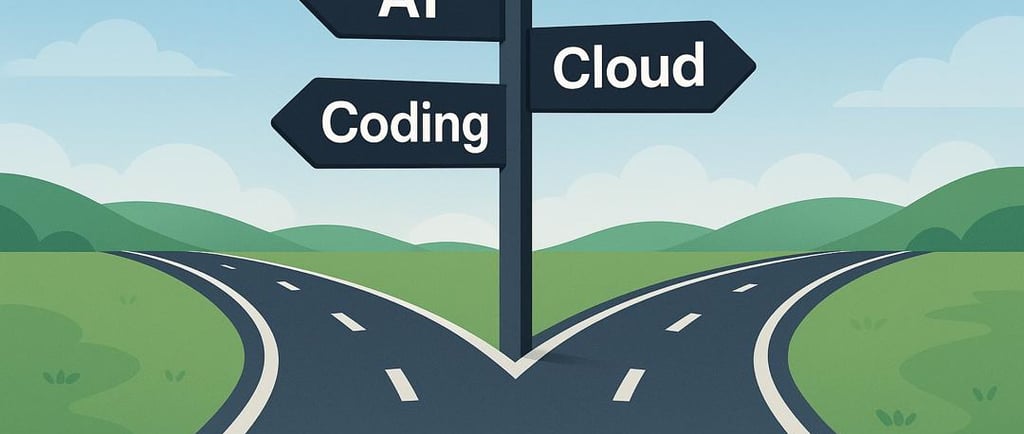
Master Tech skills on the go...
AI, Cloud, or Coding? Choosing the Right Tech Field for Career Changers
AI, cloud, or coding? Discover data‑backed insights, hands‑on roadmaps, and expert tools to help career changers choose and succeed in AI, cloud computing or coding.
TECH CAREER PLAYBOOKS
By OnlineTechSkills Editorial Team
4/23/20257 min read


Introduction
The tech industry is booming faster than ever. From generative AI astonishing the world with human‑like text and images to cloud platforms powering everything from streaming services to enterprise applications and traditional software development still at the heart of digital products, the possibilities are staggering. If you’re making a career pivot into technology, you face an exciting but daunting question: should you focus on AI, cloud computing, or coding/software development? Each path offers unique rewards, challenges, and skill sets.
In this guide, we’ll break down the core considerations, spotlight real‑world success stories, and provide an action plan to help you choose the right field based on your background, interests, and career goals.
Key Considerations before choosing a career in AI, Cloud or Coding
1. Assess Your Background and Transferable Skills
Your existing experience can accelerate your learning curve. Have you worked in finance, marketing, or healthcare? Domain expertise often translates into specialized tech roles, think AI for fintech or cloud solutions for health care. Even if you lack domain-specific knowledge, soft skills like problem‑solving, clear communication, and project management are invaluable across AI, cloud, and coding disciplines.
Consider your learning style and available time commitment. Do you prefer structured, cohort‑based learning (bootcamps or instructor‑led courses) or self‑paced online modules? Will you be balancing a job or family obligations during training? Answering these questions upfront will help you choose not only a field but also the right learning approach to succeed.
2. Market Demand and Growth Trajectories
AI: Roles like AI engineer, ML scientist, and prompt engineer are in skyrocketing demand. According to a LinkedIn Jobs report, AI-related postings grew by over 40% year-over-year in 2024. Organizations invest heavily in natural language processing, computer vision, and recommendation engines.
Cloud Computing: The shift to cloud infrastructure shows no sign of slowing. AWS, Azure, and Google Cloud Platform certifications have become gold standards. DevOps and cloud architects remain among the most sought‑after positions, with average salaries upwards of $120 K per year.
Coding/Software Development: Classic software engineering roles remain plentiful. Full‑stack, front‑end, back‑end, and mobile app developers continue to drive digital product launches. Frameworks such as React, Vue, and Next.js make front‑end skills especially marketable.
3. Entry Barriers and Learning Curve
Prerequisites: AI often requires a grounding in mathematics, statistics, and Python programming. Cloud computing demands familiarity with Linux, networking, and infrastructure‑as‑code tools. Coding roles can range from JavaScript for front‑end work to Python or Java for back‑end systems.
Cost: Consider course fees, exam vouchers, and any cloud credits you may need. Many providers offer free tiers and student discounts. Open‑source AI libraries like TensorFlow and PyTorch help keep costs manageable, while free coding bootcamp resources abound online.
Community and Mentorship: Joining forums, Slack communities, and local meetups can accelerate growth. For structured mentorship, look into programs like Women in Tech, local tech chapters, and pairing opportunities on GitHub.
Artificial Intelligence (AI)
1. What AI Roles Look Like Today
AI/ML Engineer: Builds and deploys machine learning models into production.
Machine Learning Scientist: Conducts research to improve model architectures and performance.
Prompt Engineer: Designs effective prompts to extract optimal results from large language models.
2. Required Skills and Tools
Programming Languages: Python (primary), R (for statistical work).
Libraries & Frameworks: TensorFlow, PyTorch, scikit‑learn.
Data Management: SQL, pandas, data visualization (Matplotlib, Seaborn).
Emerging Discipline: Prompt engineering crafting queries that guide AI to produce the desired output. Beginners can start with A Beginner’s Guide to Prompt Engineering with AI Tools.
3. Case Study: Sara’s Move from Marketing to Prompt Engineering
Background: Sara had five years in digital marketing but no formal coding experience. Her strength lay in crafting compelling messaging and understanding audience psychology.
Pathway:
Intro to Python: Completed an online Python fundamentals course in six weeks.
Prompt Engineering Crash Course: Followed an interactive curriculum and experimented with ChatGPT leveraging AI‑Powered Learning: ChatGPT as a Personalized Coding Tutor to debug code snippets.
Portfolio Project: Built a chatbot that generated marketing copy variations based on user inputs.
Networking & Interview Prep: Joined Slack communities for AI enthusiasts and participated in prompt engineering hackathons.
Outcome: Within six months, Sara landed a junior prompt engineer role at a marketing‑tech startup, earning a 30% salary bump.
4. Pros, Cons, and Next Steps for AI
Pros: High salaries, cutting‑edge innovations, remote flexibility.
Cons: Steep math and algorithmic demands, rapid tooling updates requiring continual upskilling.
Next Steps:
Enroll in a specialized ML or AI track on Coursera or edX.
Contribute to an open‑source model repository on GitHub.
Develop a niche by combining AI with your domain expertise (e.g., AI for healthcare or AI-driven analytics for finance).
Cloud Computing
1. What Cloud Roles Entail
Cloud Administrator: Manages cloud resources, billing, and user access.
Cloud Architect: Designs scalable, secure cloud infrastructure and migration strategies.
DevOps Engineer: Automates CI/CD pipelines, infrastructure‑as‑code, and monitoring solutions.
2. Required Skills and Tools
Operating Systems: Linux fundamentals, shell scripting.
Networking Concepts: Virtual private clouds, load balancers, DNS, VPNs.
Infrastructure as Code & Orchestration: Terraform, AWS CloudFormation, Kubernetes.
Platforms: AWS, Azure, Google Cloud Platform (GCP).
For structured learning, check out the Best Online Platforms to Learn Practical Tech Skills in 2025.
3. Case Study: Luis’s Transition from Retail to Cloud DevOps
Background: Luis was a retail operations manager who coordinated inventory and logistics systems. He already had exposure to enterprise software challenges.
Pathway:
AWS Certified Solutions Architect Associate: Studied for eight weeks using online labs and practice exams.
Hands‑On Labs: Built a multi‑tier web application on AWS using Terraform, implemented auto‑scaling groups, and configured CloudWatch alarms.
Open‑Source Contribution: Automated deployment scripts for a nonprofit’s server infrastructure on GitHub.
Mentorship: Paired with a senior DevOps engineer through a local cloud user group to refine architecture designs.
Outcome: Nine months later, Luis secured a DevOps role at a growing fintech firm, doubling his previous salary.
4. Pros, Cons, and Next Steps for Cloud
Pros: Clear certification pathways, strong enterprise demand, abundant vendor resources and community support.
Cons: Risk of vendor lock‑in, can be narrower in scope compared to full‑stack development.
Next Steps:
Obtain an entry‑level certification (AWS Certified Cloud Practitioner or Azure Fundamentals).
Join regional cloud provider user groups and attend monthly webinars or virtual meetups.
Build and deploy a small serverless project (e.g., a REST API with AWS Lambda) and showcase it on GitHub.
Coding and Software Development
1. What Coding Roles Look Like
Front‑End Developer: Focuses on user interfaces with HTML, CSS, JavaScript, and frameworks like React or Vue.
Back‑End Developer: Implements server logic and APIs with languages like Python, Java, or Node.js.
Full‑Stack Developer: Bridges front‑ and back‑end responsibilities, often working across the entire technology stack.
2. Required Skills and Tools
Languages & Frameworks: JavaScript (ES6+), React, Vue.js, Node.js, Python, Java.
Version Control: Git and GitHub workflows.
Development Practices: Agile methodologies, unit testing (Jest, Mocha), CI/CD pipelines.
For a proven path into front‑end development, explore the Roadmap: Front‑End Developer in 90 Days.
3. Case Study: Maria’s Leap from Education to Full‑Stack Developer
Background: As a high‑school teacher, Maria honed lesson planning, communication, and presentation skills. She was eager to tackle more technical challenges.
Pathway:
Coding Bootcamp: Completed a 12‑week immersive program covering JavaScript fundamentals, React, and Node.js.
Personal Projects: Built a responsive single‑page application with React, an interactive quiz platform; see How to Build a Responsive SPA with React.
Open‑Source & Networking: Contributed to documentation and minor bug fixes for a Vue.js charting library, enhancing her understanding of real‑world codebases.
Interview Prep: Practiced pair programming sessions, whiteboarding algorithms, and studied system design basics.
Outcome: Within four months of intensive study, Maria accepted an offer as a junior full‑stack developer at a digital agency, increasing her annual income by 50%.
4. Pros, Cons, and Next Steps for Coding
Pros: Broad set of opportunities, high creativity, plentiful remote and freelance roles.
Cons: Intense competition in popular stacks, constant need to learn new frameworks and libraries.
Next Steps:
Build a public GitHub portfolio featuring 2–3 polished projects.
Engage in coding challenges (e.g., LeetCode, HackerRank) to sharpen problem‑solving skills.
Contribute to open‑source projects that align with your interests and desired expertise.
Comparing the Three Paths Side by Side
When it comes to average salaries, AI roles typically range from $110 K to $150 K, cloud computing positions fall between $100 K and $140 K, and software development roles usually offer between $90 K and $130 K. Entry barriers differ: AI often demands strong math and algorithm skills, cloud computing relies on certifications and Linux fundamentals, and coding roles require proficiency in programming languages. Learning curves also vary. AI has a steep incline due to machine learning concepts and statistics, cloud computing requires a moderate pace to master infrastructure-as-code and networking, while software development’s curve depends on the chosen stack. Certification-wise, AI leans on portfolios and project experience, cloud computing benefits from AWS/Azure/GCP credentials, and software developers can pursue language-specific or platform certifications. Finally, job postings for AI grow by around 40% annually, cloud roles by roughly 30%, and software development sees consistent growth of 20%–25%.
For a deeper dive into aligning your strengths with these paths, see How to Choose the Right Tech Career Path Based on Your Strengths.
Action Plan for Career Changers
Self‑Assessment Exercises: Identify your top transferable skills such as communication, analysis, and domain knowledge. Write them down and map them to the demands of AI, cloud, and development roles.
Micro‑Credentials and Low‑Risk Experiments: Take free introductory courses (Coursera, Udemy, or vendor‑provided) in each area to gauge your affinity.
Networking & Community Engagement: Join relevant Slack/Discord channels, local Meetup events, and LinkedIn groups. Engage by asking questions and sharing small projects.
Personal Branding: Craft a targeted resume, LinkedIn profile, and GitHub portfolio that reflect your chosen path. Highlight projects, certifications, and relevant soft skills.
Continuous Learning Mindset: Subscribe to industry newsletters, follow thought leaders on Twitter/LinkedIn, and commit to monthly upskilling sprints.
For an up‑to‑date list of in‑demand skills, check out Top 7 Tech Skills to Learn in 2025 (No Experience Needed).
Conclusion
AI, cloud computing, and software development each offer compelling career trajectories for ambitious career changers. The right choice hinges on your background, interests, and the lifestyle you envision. There’s no one‑size‑fits‑all answer experimentation and iteration will guide you toward the best fit.
Call‑to‑Action: Try this tip today, choose one free beginner tutorial (AI prompt coding, cloud fundamentals, or a basic web app), spend 30 minutes exploring, and share your progress in a community forum. The best way to find your path is to start walking it.
Insights
Explore our free and top ranking blogs for in-demand tech skills.
CONTACT US
Support
support@onlinetechskills.com
© 2025. All rights reserved.